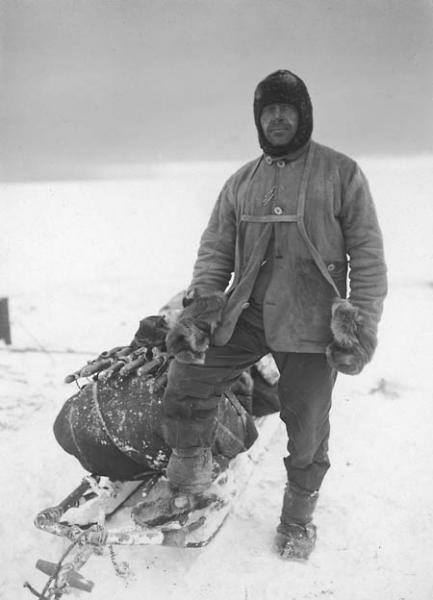Felix Baumgartner, who has become the first skydiver to go through the sound barrier, says the main goal of his exploit was to collect scientific data.
The aim, his team insists, is to assist in the development of high-altitude parachute systems that will save lives when spacecraft are evacuated in the stratosphere.
There is a long history of people undertaking daring feats and helping science into the bargain. Here are five examples.
1. Captain Robert Falcon Scott
Robert Falcon Scott is famed as the explorer who lost the race to the South Pole and who led his team to their deaths on the return journey. But his expedition also laid the foundations of modern polar science, says historian David Wilson, great-nephew of Scott’s naturalist, Edward Wilson. One of the fossils found alongside Scott’s frozen body was of a beech-like tree, Glossoptera indica, which proved that Antarctica and Australia had once been part of an ancient super-continent – and “helped us change our geological understanding of the planet” according to Wilson. Scott also collected the first Emperor penguin eggs. These disproved the theory, then current, that an embryo passed through all the stages of its species’ evolution as it developed. Scientists had expected the eggs to show the link between dinosaurs and birds – but they didn’t.
2. George Hedley Stainforth
On 29 September 1931, RAF pilot George Hedley Stainforth became the first man in the world to exceed 400 mph (643 km). This broke the record set by his team earlier that year during a competition for the Schneider Trophy, in five races around the waters of the Solent, in the UK, watched by hundreds of thousands of people. The seaplane used, the Supermarine S.6, was designed by RJ Mitchell, who used it as the basis for the Hurricane, and also the Spitfire – one of the fastest fighters of its time, which became the backbone of RAF Fighter Command in World War II. The Schneider trophy was crucial to the defeat of Germany, says pilot John Russell.
“If they hadn’t done that exponential development of aeronautics and engine development over the 18 years it took place, then we wouldn’t really have the aircraft like the Hurricane and Spitfire to be available by the time of the Battle of Britain.”
The competition, set up by a French industrialist to encourage technical advances in aviation, ran from 1913 to 1931, with a gap during World War I. George Hedley Stainforth went on to break the world record for flying upside-down – for 12 minutes.
3. John Paul Stapp
In 1954, US Air Force medical researcher John Paul Stapp earned the title “the Fastest Man Alive” when he rode a rocket-powered sled to a then-world record land speed of 632 mph (1.017 km/h), going from a standstill to a speed faster than a 45-caliber bullet in five seconds. He then screeched to a dead stop in 1.4 seconds, sustaining a force equivalent to 46.2 times gravity. It was an experiment that tested the limits of human endurance, with the aim of making transportation safer. He suffered broken bones and detached retinas, but out of these wild rides – by December 1954, Stapp had volunteered for 29 rocket sled deceleration and windblast experiments – came improved helmets, arm and leg restraints, better aircraft seats, stronger safety harnesses and techniques for positioning the body to help absorb powerful forces.
As he had long felt that the safety measures he was developing for military aircraft should also be used for civilian automobiles, John Paul Stapp also campaigned for the installation of seat belts and other safety features in American cars. He was in the room on 9 September 1966 when US President Lyndon Johnson signed the Highway Safety Act of 1966, requiring seatbelts in all new cars sold in the US.
According to the official website of the US Air Force, John Paul Stapp is also credited with coining one of the most famous phrases in American history when he suffered injuries owing to a mistake by one of his assistants Captain Murphy. After he discovered what happened, Stapp observed that “Whatever can go wrong, will go wrong.” It’s been called “Murphy’s Law” ever since.
4. Yuri Gagarin
Russian cosmonaut Yuri Gagarin became an international celebrity on 12 April 1961, when he became the first man in space – effectively, a human guinea pig. His single orbit of Earth during a 108-minute flight – reaching an altitude of 203 miles, and a speed of 17,025 mph (27,000 km/h) – proved that man could endure the rigors of lift-off, re-entry, and weightlessness. It launched the era of manned spaceflight, and intensified the superpower space race that had begun with the launch of Sputnik, the first satellite, in 1957.
In fact, Yuri Gagarin almost lost consciousness for a different reason – a service module failed to separate from Gagarin’s capsule before he returned to earth, leading it to spin wildly and the temperature within to rise dangerously high.
5. Dan Martin
When intensive care consultant Dan Martin climbed Everest, he reported the lowest level of oxygen in the human body ever recorded – his own. While not a daredevil as such, he is part of a team of doctors studying how the human body behaves in low-oxygen environments, in particular at high altitude, and drawing lessons for treatment of critically ill patients.
“When people go into intensive care, they commonly suffer with low levels of oxygen in their blood. Some can tolerate it, some can’t. Our understanding of it is very poor,” he says.
The team has already established that giving patients lots of oxygen in intensive care does not necessarily lead to better outcomes. It has also noted that Sherpas have high levels of nitric oxide in their blood, and is experimenting with raising levels of nitric oxide in the blood of patients.
